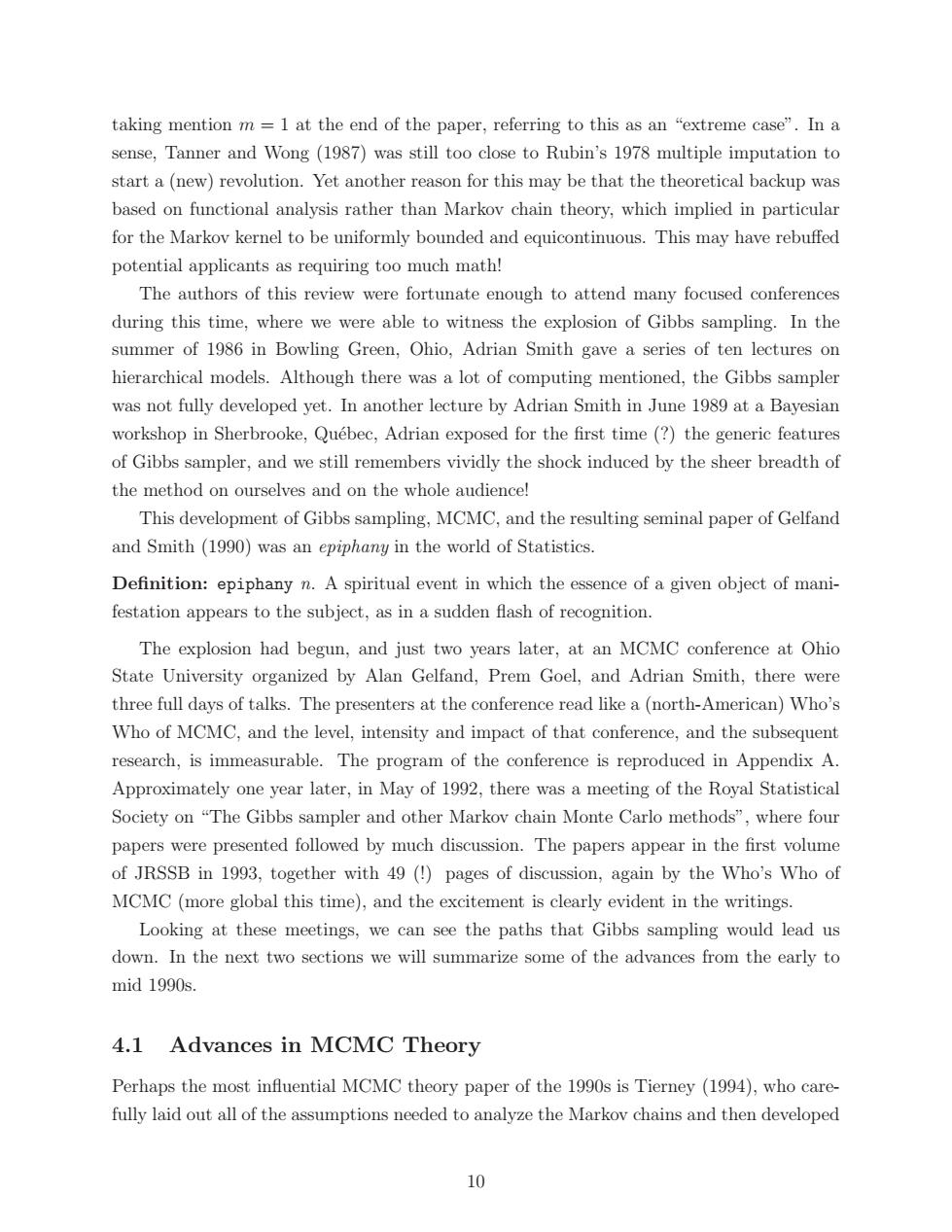正在加载图片...

taking mention m =1 at the end of the paper,referring to this as an "extreme case".In a sense,Tanner and Wong (1987)was still too close to Rubin's 1978 multiple imputation to start a(new)revolution.Yet another reason for this may be that the theoretical backup was based on functional analysis rather than Markov chain theory,which implied in particular for the Markov kernel to be uniformly bounded and equicontinuous.This may have rebuffed potential applicants as requiring too much math! The authors of this review were fortunate enough to attend many focused conferences during this time,where we were able to witness the explosion of Gibbs sampling.In the summer of 1986 in Bowling Green,Ohio,Adrian Smith gave a series of ten lectures on hierarchical models.Although there was a lot of computing mentioned,the Gibbs sampler was not fully developed yet.In another lecture by Adrian Smith in June 1989 at a Bayesian workshop in Sherbrooke,Quebec,Adrian exposed for the first time (?the generic features of Gibbs sampler,and we still remembers vividly the shock induced by the sheer breadth of the method on ourselves and on the whole audience! This development of Gibbs sampling,MCMC,and the resulting seminal paper of Gelfand and Smith (1990)was an epiphany in the world of Statistics. Definition:epiphany n.A spiritual event in which the essence of a given object of mani- festation appears to the subject,as in a sudden flash of recognition. The explosion had begun,and just two years later,at an MCMC conference at Ohio State University organized by Alan Gelfand,Prem Goel,and Adrian Smith,there were three full days of talks.The presenters at the conference read like a(north-American)Who's Who of MCMC,and the level,intensity and impact of that conference,and the subsequent research,is immeasurable.The program of the conference is reproduced in Appendix A. Approximately one year later,in May of 1992,there was a meeting of the Royal Statistical Society on "The Gibbs sampler and other Markov chain Monte Carlo methods",where four papers were presented followed by much discussion.The papers appear in the first volume of JRSSB in 1993,together with 49 (!)pages of discussion,again by the Who's Who of MCMC(more global this time),and the excitement is clearly evident in the writings. Looking at these meetings,we can see the paths that Gibbs sampling would lead us down.In the next two sections we will summarize some of the advances from the early to mid 1990s. 4.1 Advances in MCMC Theory Perhaps the most influential MCMC theory paper of the 1990s is Tierney (1994),who care- fully laid out all of the assumptions needed to analyze the Markov chains and then developed 10taking mention m = 1 at the end of the paper, referring to this as an “extreme case”. In a sense, Tanner and Wong (1987) was still too close to Rubin’s 1978 multiple imputation to start a (new) revolution. Yet another reason for this may be that the theoretical backup was based on functional analysis rather than Markov chain theory, which implied in particular for the Markov kernel to be uniformly bounded and equicontinuous. This may have rebuffed potential applicants as requiring too much math! The authors of this review were fortunate enough to attend many focused conferences during this time, where we were able to witness the explosion of Gibbs sampling. In the summer of 1986 in Bowling Green, Ohio, Adrian Smith gave a series of ten lectures on hierarchical models. Although there was a lot of computing mentioned, the Gibbs sampler was not fully developed yet. In another lecture by Adrian Smith in June 1989 at a Bayesian workshop in Sherbrooke, Qu´ebec, Adrian exposed for the first time (?) the generic features of Gibbs sampler, and we still remembers vividly the shock induced by the sheer breadth of the method on ourselves and on the whole audience! This development of Gibbs sampling, MCMC, and the resulting seminal paper of Gelfand and Smith (1990) was an epiphany in the world of Statistics. Definition: epiphany n. A spiritual event in which the essence of a given object of manifestation appears to the subject, as in a sudden flash of recognition. The explosion had begun, and just two years later, at an MCMC conference at Ohio State University organized by Alan Gelfand, Prem Goel, and Adrian Smith, there were three full days of talks. The presenters at the conference read like a (north-American) Who’s Who of MCMC, and the level, intensity and impact of that conference, and the subsequent research, is immeasurable. The program of the conference is reproduced in Appendix A. Approximately one year later, in May of 1992, there was a meeting of the Royal Statistical Society on “The Gibbs sampler and other Markov chain Monte Carlo methods”, where four papers were presented followed by much discussion. The papers appear in the first volume of JRSSB in 1993, together with 49 (!) pages of discussion, again by the Who’s Who of MCMC (more global this time), and the excitement is clearly evident in the writings. Looking at these meetings, we can see the paths that Gibbs sampling would lead us down. In the next two sections we will summarize some of the advances from the early to mid 1990s. 4.1 Advances in MCMC Theory Perhaps the most influential MCMC theory paper of the 1990s is Tierney (1994), who carefully laid out all of the assumptions needed to analyze the Markov chains and then developed 10